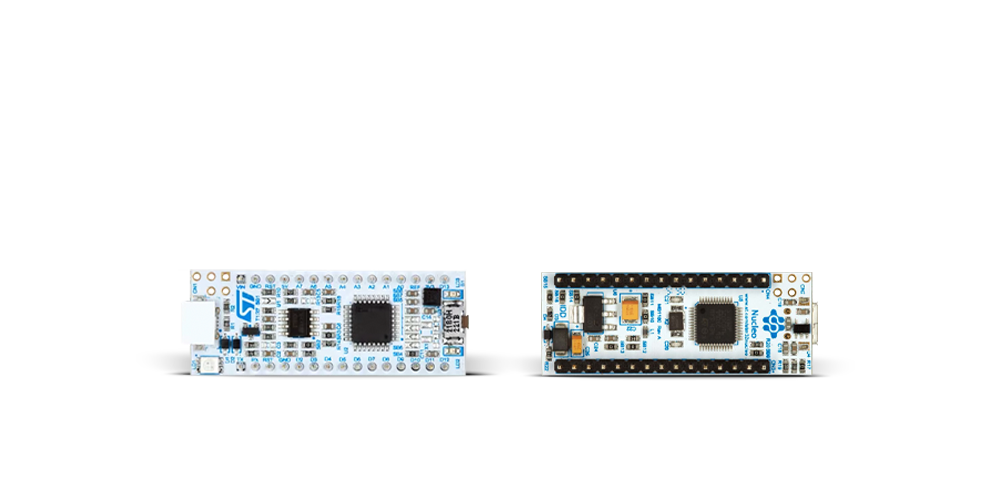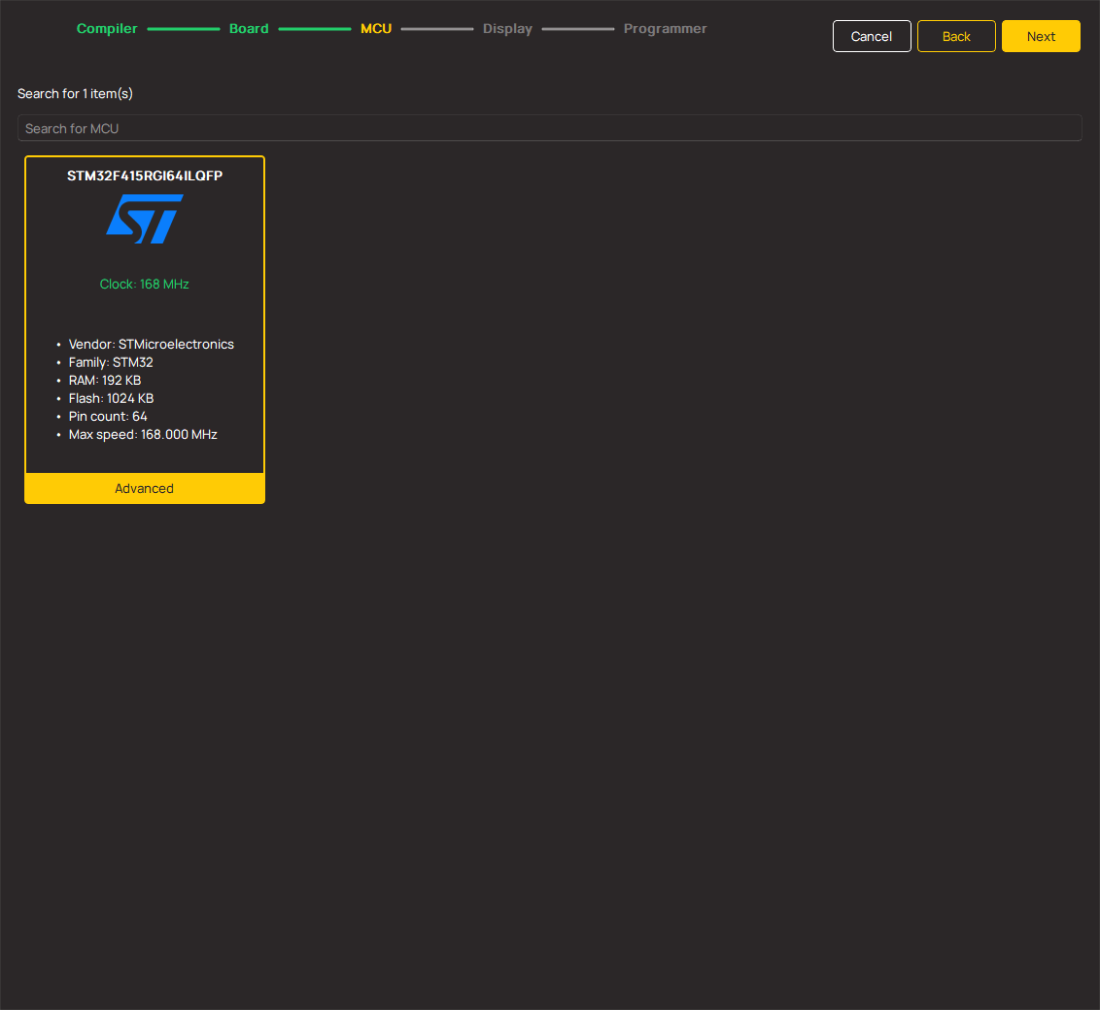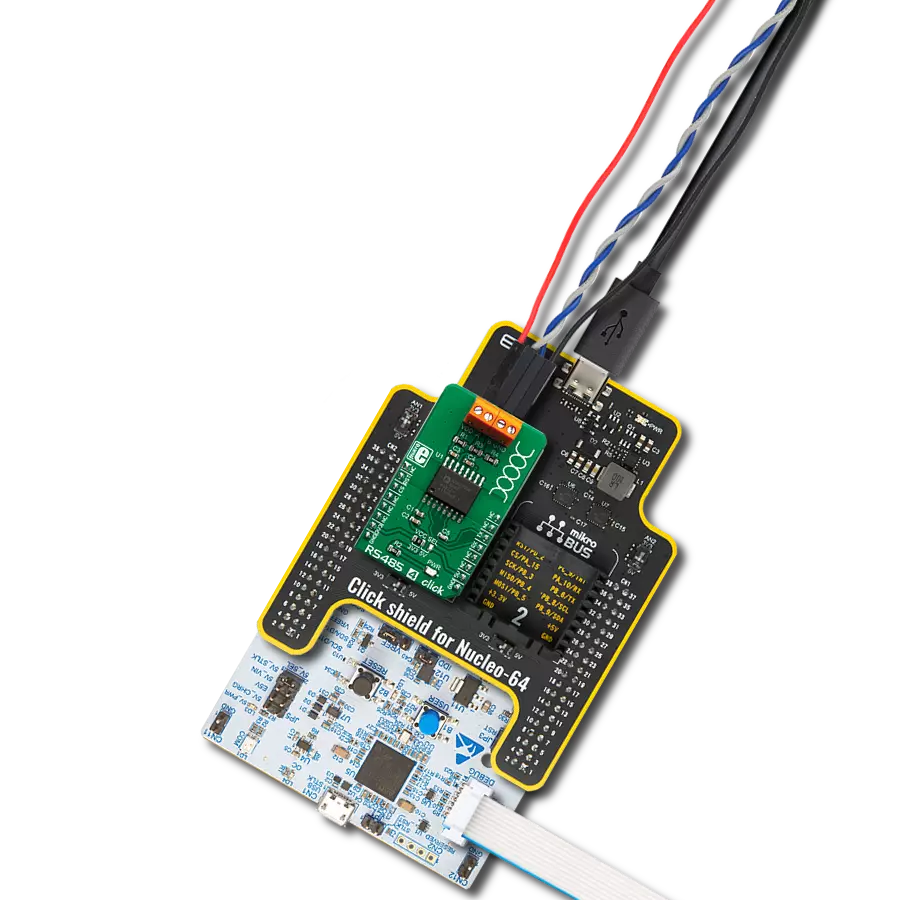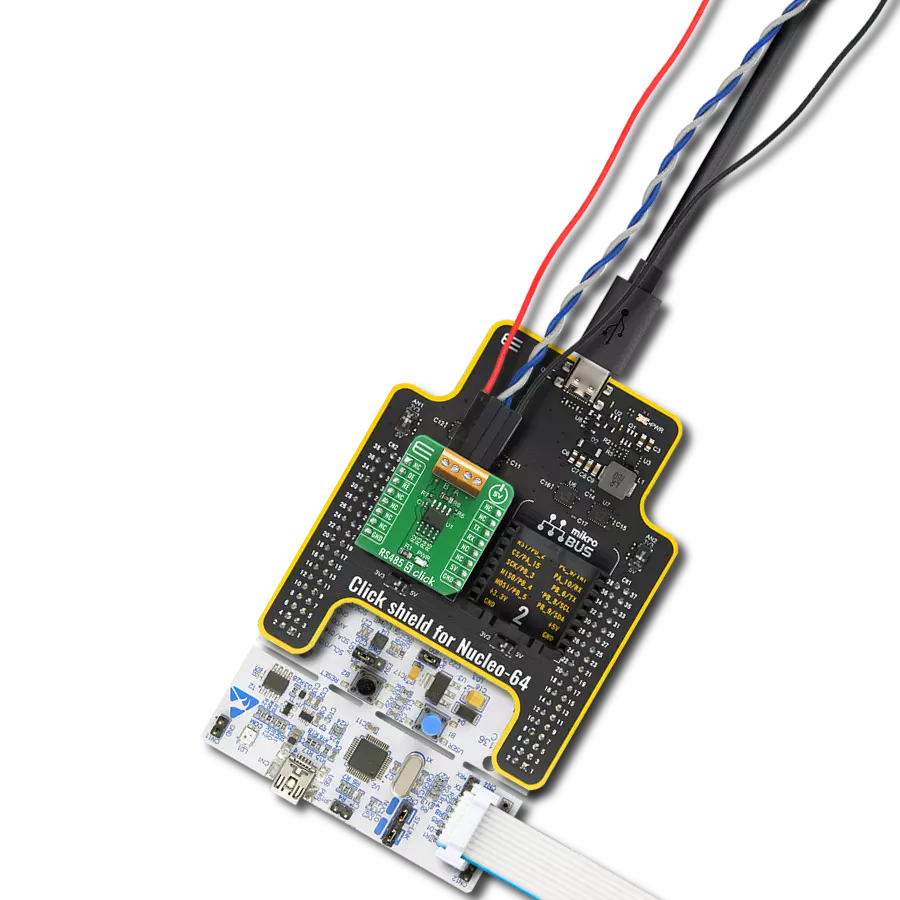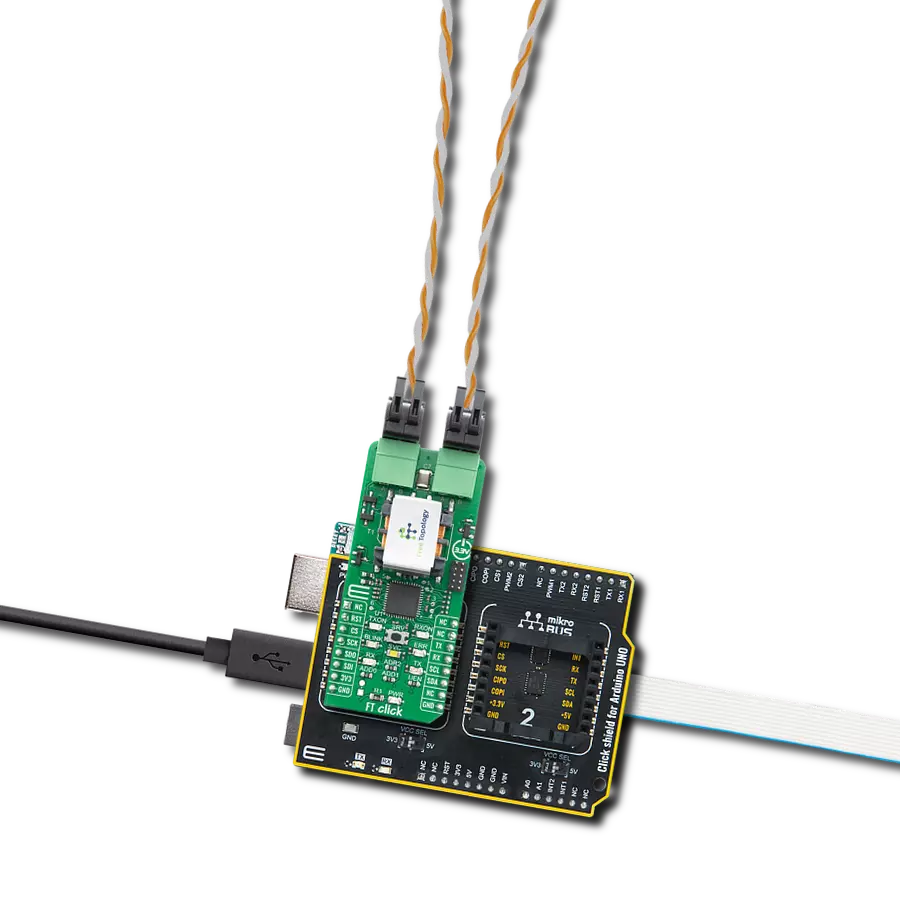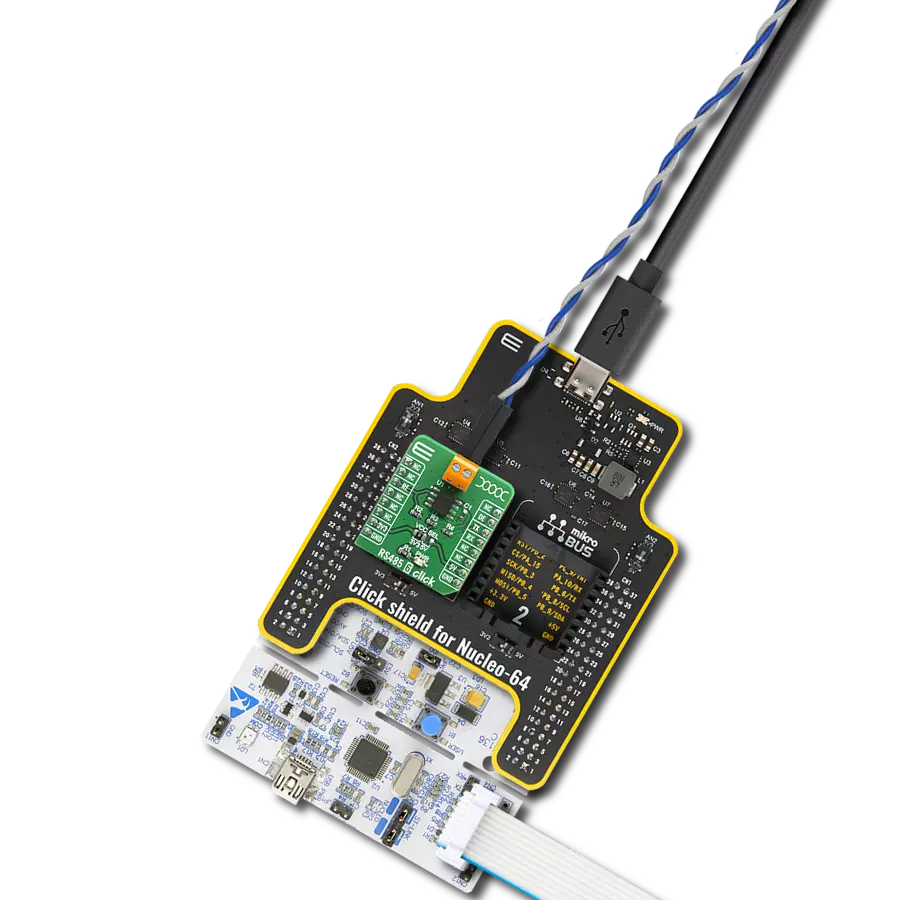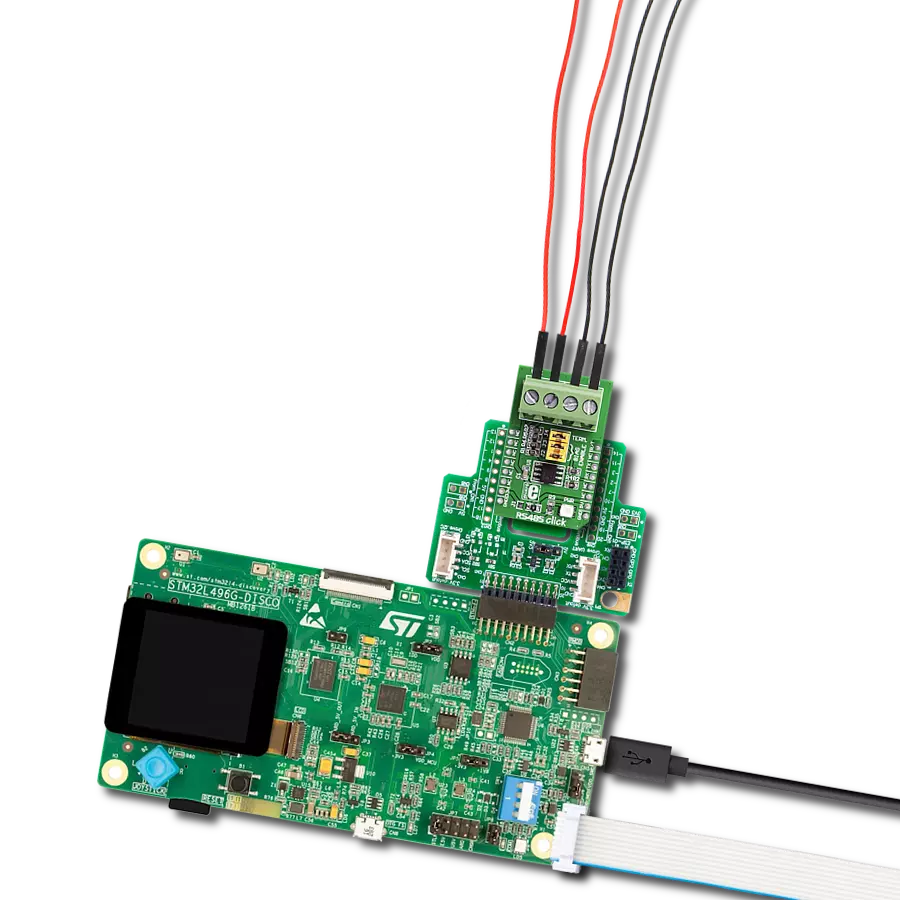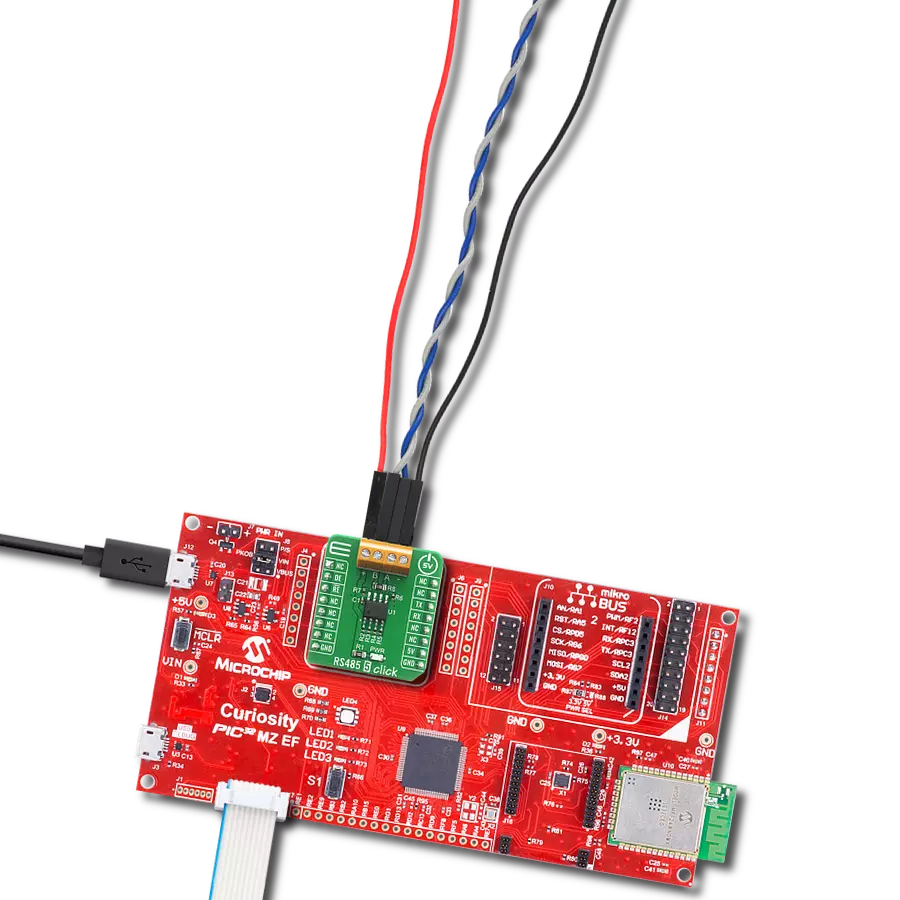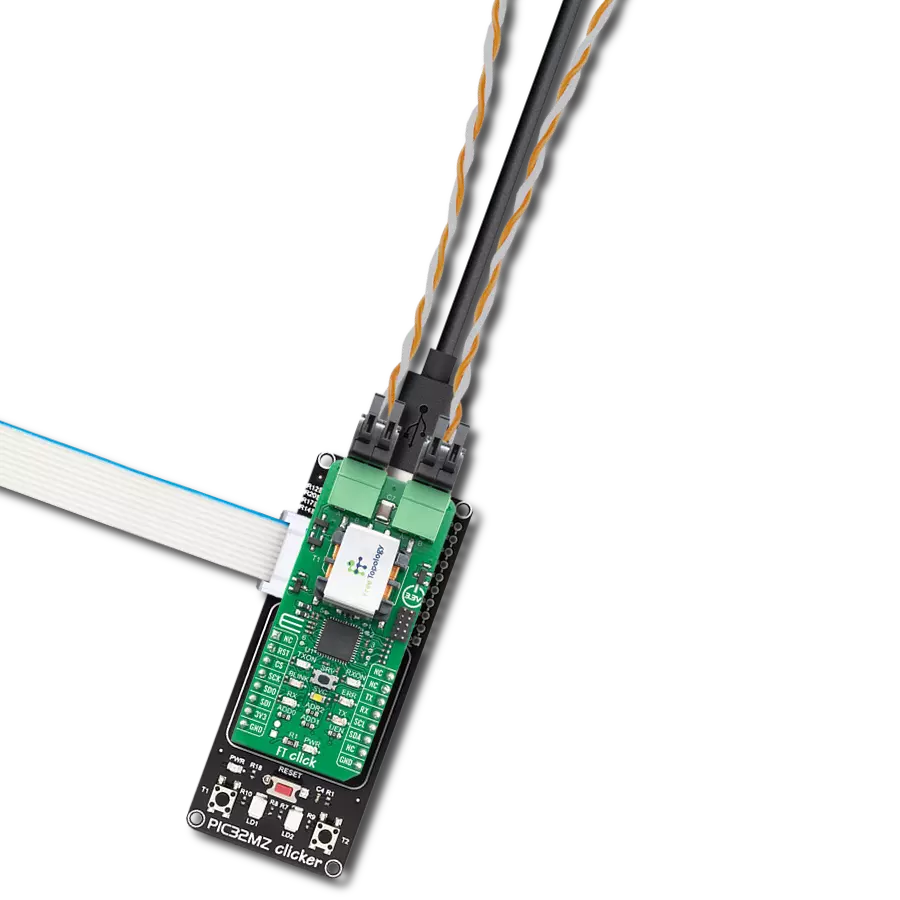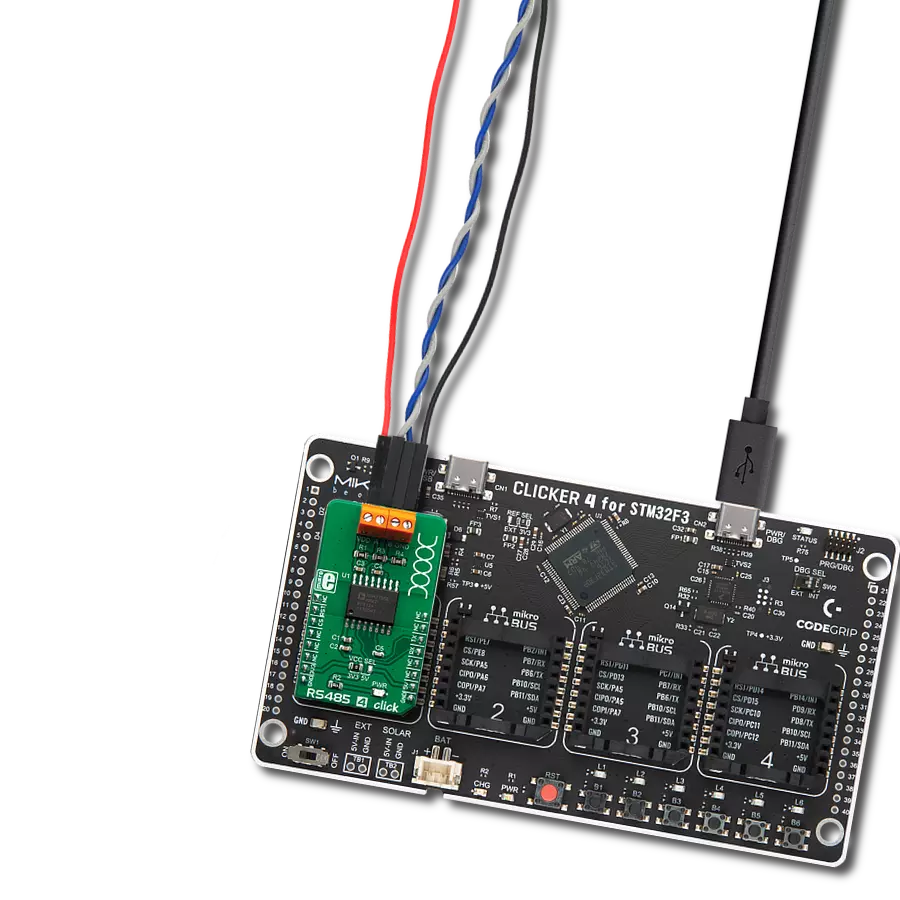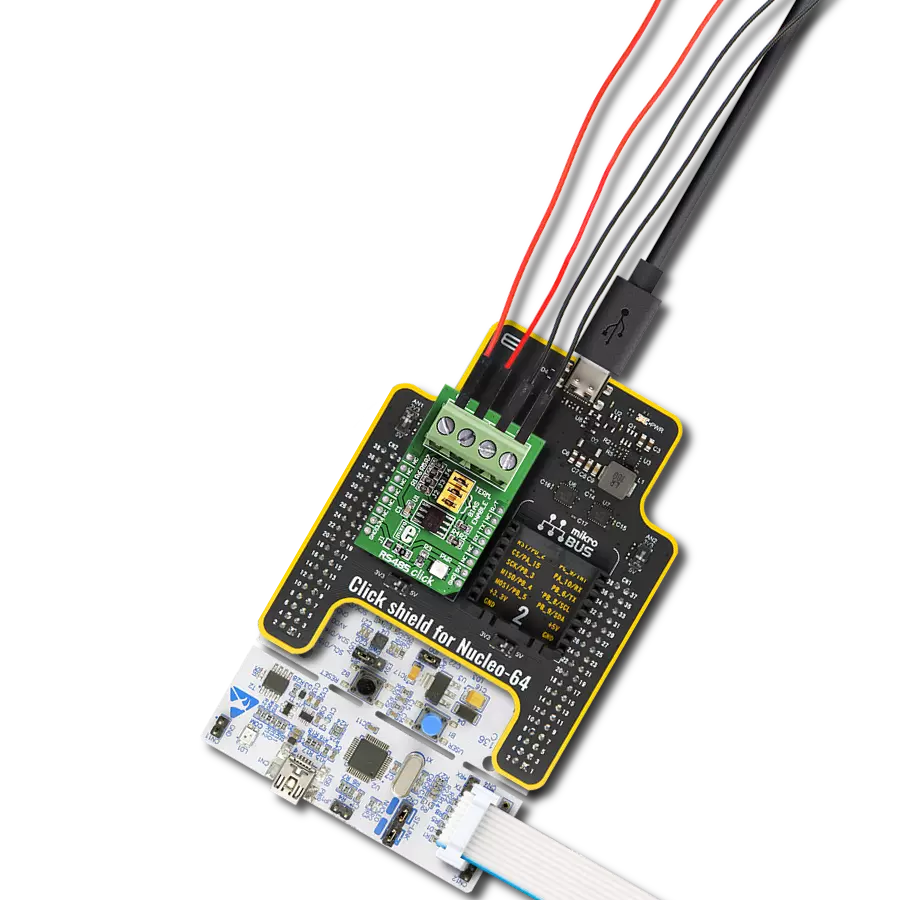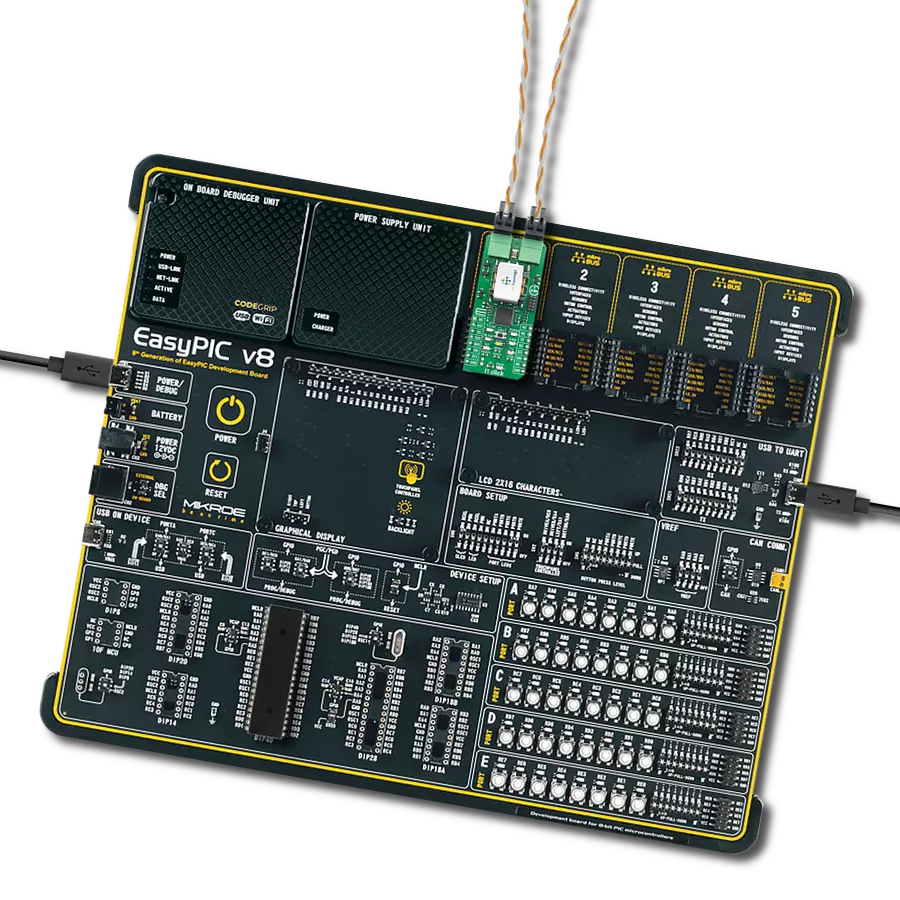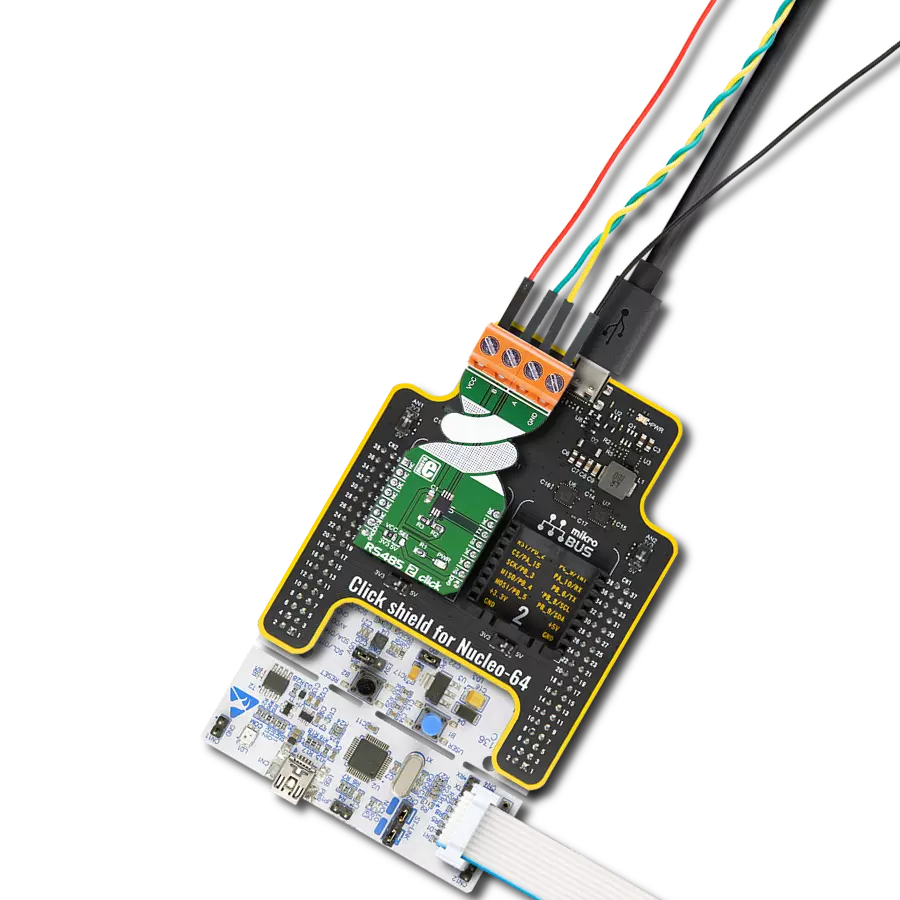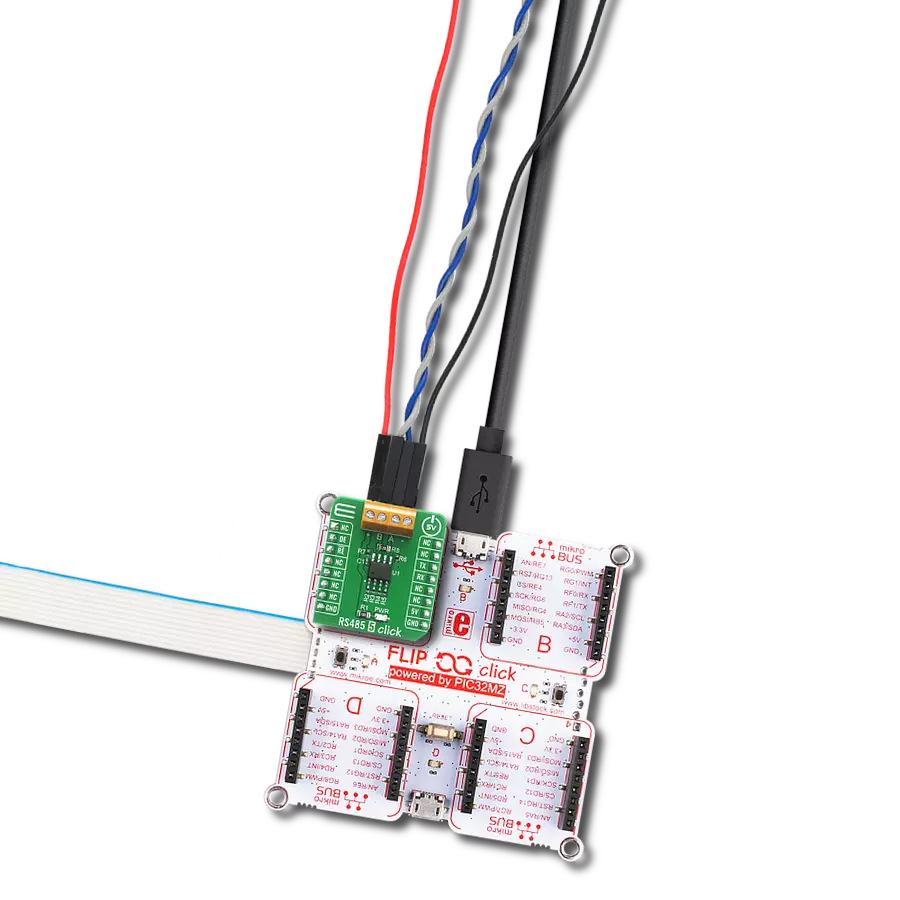Our RS485 signal isolator empowers your communication network by providing robust isolation, ensuring reliable data transmission in industrial environments
A
A
Hardware Overview
How does it work?
RS485 Isolator Click is based on the ADM2682E, a signal, and a power-isolated RS-485 transceiver with ESD protection from Analog Devices. The signal isolation is implemented on the logic side of the interface, which is achieved by having a digital isolation section and a transceiver section. The applied data to the RX and DE pins are referenced to a logic ground and coupled across an isolated barrier to appear at the transceiver section referenced to the isolated ground. Similarly, the single-ended receiver output signal, referenced to
isolated ground in the transceiver section, is coupled across the isolation barrier to appear at the RX pin referenced to logic ground. RS485 Isolator Click uses a standard 2-Wire UART interface to communicate with the host MCU. There is driver enable input DE, which enables the driver with logic HIGH. The receiver-enable input RE enables the receiver with a LOW logic state. There is also a TERM jumper, which adds a 120R termination resistor at the receiver side of the bus, which minimizes the reflections. The input/output
terminal is properly labeled A and B for receiver input and Z and Y for driver output. This Click board™ can operate with either 3.3V or 5V logic voltage levels selected via the VCC SEL jumper. This way, both 3.3V and 5V capable MCUs can use the communication lines properly. Also, this Click board™ comes equipped with a library containing easy-to-use functions and an example code that can be used as a reference for further development.
Features overview
Development board
Nucleo 32 with STM32F031K6 MCU board provides an affordable and flexible platform for experimenting with STM32 microcontrollers in 32-pin packages. Featuring Arduino™ Nano connectivity, it allows easy expansion with specialized shields, while being mbed-enabled for seamless integration with online resources. The
board includes an on-board ST-LINK/V2-1 debugger/programmer, supporting USB reenumeration with three interfaces: Virtual Com port, mass storage, and debug port. It offers a flexible power supply through either USB VBUS or an external source. Additionally, it includes three LEDs (LD1 for USB communication, LD2 for power,
and LD3 as a user LED) and a reset push button. The STM32 Nucleo-32 board is supported by various Integrated Development Environments (IDEs) such as IAR™, Keil®, and GCC-based IDEs like AC6 SW4STM32, making it a versatile tool for developers.
Microcontroller Overview
MCU Card / MCU
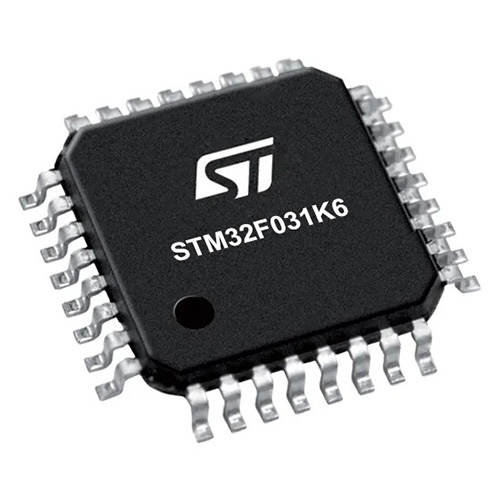
Architecture
ARM Cortex-M0
MCU Memory (KB)
32
Silicon Vendor
STMicroelectronics
Pin count
32
RAM (Bytes)
4096
You complete me!
Accessories
Click Shield for Nucleo-32 is the perfect way to expand your development board's functionalities with STM32 Nucleo-32 pinout. The Click Shield for Nucleo-32 provides two mikroBUS™ sockets to add any functionality from our ever-growing range of Click boards™. We are fully stocked with everything, from sensors and WiFi transceivers to motor control and audio amplifiers. The Click Shield for Nucleo-32 is compatible with the STM32 Nucleo-32 board, providing an affordable and flexible way for users to try out new ideas and quickly create prototypes with any STM32 microcontrollers, choosing from the various combinations of performance, power consumption, and features. The STM32 Nucleo-32 boards do not require any separate probe as they integrate the ST-LINK/V2-1 debugger/programmer and come with the STM32 comprehensive software HAL library and various packaged software examples. This development platform provides users with an effortless and common way to combine the STM32 Nucleo-32 footprint compatible board with their favorite Click boards™ in their upcoming projects.
Used MCU Pins
mikroBUS™ mapper
Take a closer look
Click board™ Schematic
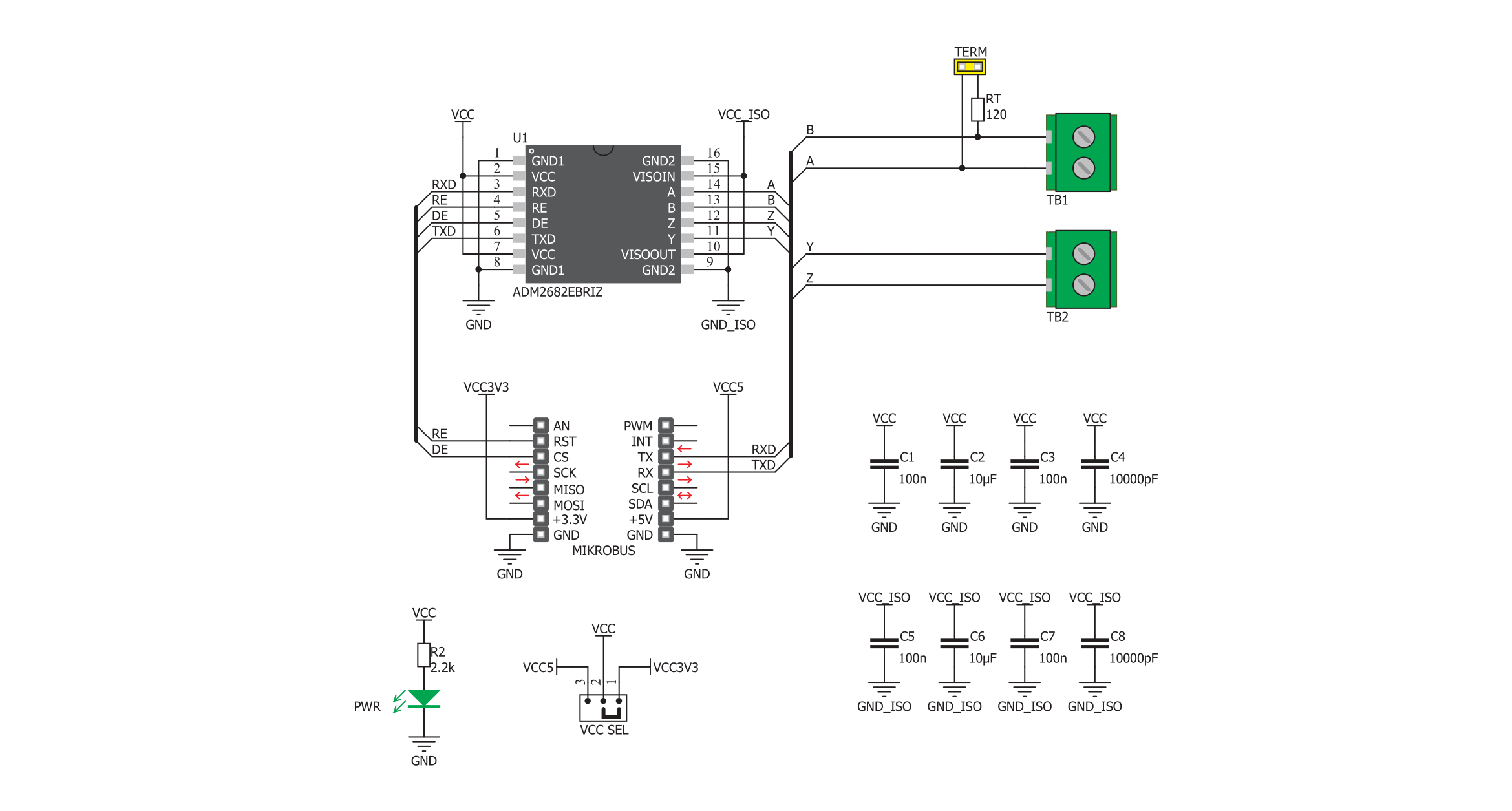
Step by step
Project assembly
Software Support
Library Description
This library contains API for RS485 Isolator Click driver.
Key functions:
rs485isolator_set_receiver_mode- Set receiver state.rs485isolator_generic_read- Generic read function.rs485isolator_generic_write- Generic write function.
Open Source
Code example
The complete application code and a ready-to-use project are available through the NECTO Studio Package Manager for direct installation in the NECTO Studio. The application code can also be found on the MIKROE GitHub account.
/*!
* \file
* \brief RS485 Isolator Click example
*
* # Description
* This example reads and processes data from RS485 Isolator Clicks.
*
* The demo application is composed of two sections :
*
* ## Application Init
* Initializes driver.
*
* ## Application Task
* Depending on the selected mode, it reads all the received data or sends the desired message
* every 2 seconds.
*
* ## Additional Function
* - rs485isolator_process ( ) - The general process of collecting the received data.
*
* @note
* Wire connection guide : Driver(Master) Slave
* Y -> A
* Z -> B
*
* \author MikroE Team
*
*/
// ------------------------------------------------------------------- INCLUDES
#include "board.h"
#include "log.h"
#include "rs485isolator.h"
#include "string.h"
// Comment out the line below in order to switch the application mode to receiver
#define DEMO_APP_TRANSMITTER
#define TEXT_TO_SEND "MIKROE - RS485 Isolator Click\r\n"
#define PROCESS_RX_BUFFER_SIZE 100
// ------------------------------------------------------------------ VARIABLES
static rs485isolator_t rs485isolator;
static log_t logger;
// ------------------------------------------------------- ADDITIONAL FUNCTIONS
static void rs485isolator_process ( void )
{
uint8_t uart_rx_buffer[ PROCESS_RX_BUFFER_SIZE ] = { 0 };
int32_t rsp_size = rs485isolator_generic_read( &rs485isolator, uart_rx_buffer, PROCESS_RX_BUFFER_SIZE );
if ( rsp_size > 0 )
{
log_printf( &logger, "Received data: " );
for ( uint8_t check_buf_cnt = 0; check_buf_cnt < rsp_size; check_buf_cnt++ )
{
log_printf( &logger, "%c", uart_rx_buffer[ check_buf_cnt ] );
}
Delay_ms ( 100 );
rsp_size = rs485isolator_generic_read( &rs485isolator, uart_rx_buffer, PROCESS_RX_BUFFER_SIZE );
if ( rsp_size > 0 )
{
for ( uint8_t check_buf_cnt = 0; check_buf_cnt < rsp_size; check_buf_cnt++ )
{
log_printf( &logger, "%c", uart_rx_buffer[ check_buf_cnt ] );
}
}
}
Delay_ms ( 100 );
}
// ------------------------------------------------------ APPLICATION FUNCTIONS
void application_init ( void )
{
log_cfg_t log_cfg;
rs485isolator_cfg_t cfg;
/**
* Logger initialization.
* Default baud rate: 115200
* Default log level: LOG_LEVEL_DEBUG
* @note If USB_UART_RX and USB_UART_TX
* are defined as HAL_PIN_NC, you will
* need to define them manually for log to work.
* See @b LOG_MAP_USB_UART macro definition for detailed explanation.
*/
LOG_MAP_USB_UART( log_cfg );
log_init( &logger, &log_cfg );
log_info( &logger, " Application Init " );
// Click initialization.
rs485isolator_cfg_setup( &cfg );
RS485ISOLATOR_MAP_MIKROBUS( cfg, MIKROBUS_1 );
rs485isolator_init( &rs485isolator, &cfg );
log_info( &logger, " Application Task " );
}
void application_task ( void )
{
#ifdef DEMO_APP_TRANSMITTER
rs485isolator_generic_write( &rs485isolator, TEXT_TO_SEND, strlen ( TEXT_TO_SEND ) );
log_info( &logger, "---- Data sent ----" );
Delay_ms ( 1000 );
Delay_ms ( 1000 );
#else
rs485isolator_process( );
#endif
}
int main ( void )
{
/* Do not remove this line or clock might not be set correctly. */
#ifdef PREINIT_SUPPORTED
preinit();
#endif
application_init( );
for ( ; ; )
{
application_task( );
}
return 0;
}
// ------------------------------------------------------------------------ END
Additional Support
Resources
Category:RS485



